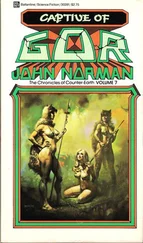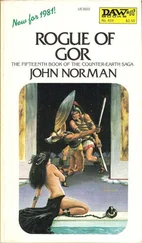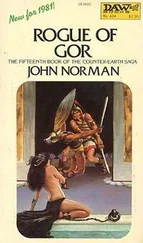I thought that was true.
“I hope for your sake,” said the leader of the she-urts to the girl, “that you are not a slave.” Then she said to the other girls, “Find pieces of rope.”
“Are we going to the praetor station?” asked one of the girls, uneasily.
“Of course,” said the leader.
“I do not want to go to the praetor station,” said one of the girls.
“We have done nothing,” said the leader. “We have nothing to fear.”
‘There are men there,” said one of the girls.
“We have men to fear,” said another.
“We are going,” said the leader, determinedly.
I picked up the Earth-girl slave, and threw her over my shoulder. She squirmed helplessly, crying. I picked up my sea bag then, and, the girl on my shoulder, the sea bag in my left hand, made my way toward the pier of the Red Urt.
“Are her thighs marked?” asked the praetor.
“No,” said a guardsman. He had already made this determination.
The girl stood, her hands bound behind her, in the brief rag of the she-urt, before the tribunal of the praetor. The neck strap of a guardsman was on her throat.
“Is this your slave?” asked the praetor of Ulafi of Schendi.
“Yes,” said he.
“How do I know she is a slave?” asked the praetor. “Her body, her movements, do not suggest that she is a slave. She seems too tight, too cold, too rigid, to be a slave.”
“She was free, captured by Bejar, in his seizure of the Blossoms of Telnus,” said Ulafi. “She is new to her condition.”
“Is Bejar present?’ asked the praetor.
“No,” said a man. Bejar had left the port yesterday, to again try his luck upon gleaming Thassa, the sea.
“Her measurements, exactly, fit those of the slave,” said a guardsman. He lifted the tape measure, marked in horts, which had been applied, but moments before, to the girl’s body.
The praetor nodded. This was excellent evidence. The girl’s height, ankles, wrists, throat, hips, waist and bust had been measured. She had even been thrown on a grain scale and weighed.
The praetor looked down at the girl. He pointed to her. “Kajira?” he asked. “Kajira?”
She shook her head vigorously. That much Gorean she at least understood. She denied being a slave girl.
The praetor made a small sign to one of the guardsmen.
“Leash!” said the fellow, suddenly, harshly, behind the girl, in Gorean.
She jumped, startled, and cried out, frightened, but she did not, as a reflex, lift her head, turning it to the left, nor did the muscles in her upper arms suddenly move as though thrusting her wrists behind her, to await the two snaps of the slave bracelets.
“Nadu!” snapped the guard. But the girl had not, involuntarily, begun to kneel.
“I have her slave papers here,” said Ulafi, “delivered with her this morning by Vart’s man.”
He handed them to the praetor.
“She does not respond as a slave because she has not yet learned her slavery,” said Ulafi. “She has not yet learned the collar and the whip.
The praetor examined the papers. In Ar slaves are often fingerprinted. The prints are contained in the papers.
“Does anyone know if this is Ulafi’s slave?” asked the praetor.
I did not wish to speak, for I would, then, have revealed myself as having been at the sale. I preferred for this to be unknown.
The four she-urts, with which the blond-haired barbarian had fished for garbage in the canal, stood about.
“She should have been marked,” said the praetor. “She should have been collared.”
“I have a collar here,” said Ulafi, lifting a steel slave collar. It was a shipping collar. It had five palms on it, and the sign of Schendi, the shackle and scimitar. The girl who wore it would be clearly identified as a portion of Ulafi’s cargo.
“I wish to sail with the tide,” said Ulafi. “In less than half an Ahn it will be full.”
“I am sorry,” said the praetor.
“Has not Vart been sent for,” asked Ulafi, “to confirm my words?”
“He has been sent for,” said the praetor.
From some eighty or so yards away, from the tiny shop of a metal worker, I heard a girl scream. I knew the sound. A girl had been marked. She who had been the Lady Sasi, the little she-urt who had been the accomplice of Turgus of Port Kar, had been branded.
“I am afraid we must release this woman,” said the praetor, looking down at the girl. “it is unfortunate, as she is attractive.”
“Test her for slave heat,” suggested a man.
“That is not appropriate,” said the praetor, “if she is free.”
“Make her squirm,” said the man. “See if she is slave hot.”
“No,” said the praetor.
The praetor looked at the girl. He looked at Ulafi.
“I am afraid I must order her release,” he said.
“No!” said Ulafi.
“Wait,” said a man. “It is Vart!”
The girl shrank back, miserably, her hands tied behind her back, the neck strap on her throat, before Vart, who had pushed through the crowd.
“Do you know this girl?” asked the praetor of Vart.
“Of course,” said Vart. “She is a slave, sold last night to this captain.” He indicated Ulafi of Schendi. “I got a silver tarsk for her.”
The praetor nodded to a guardsman. He thrust the girl down to her knees. She was in the presence of free men. With the neck strap he pulled her head down and tied it down, fastening it to her ankles by means of the neck strap; the leather between her neck and ankles, which were now crossed and bound, was short and taut. Her rag, the brown, torn tunic of the she-urt, stolen from she who had been Sasi, was then cut from her. She knelt bound then, and naked, in one of several Gorean submission positions.
“The slave is awarded to Ulafi of Schendi,” ruled the praetor.
There were cheers from the men present, and Gorean applause, the striking of the left shoulder with the right hand.
“My thanks, Praetor,” said Ulafi, receiving back the slave papers from the magistrate.
“Slave! Slave!” screamed the leader of the she-urts to the bound girl. “Slave! Slave!” they cried.
“To think we let you fish garbage with us, when you were only a slave!” cried the leader.
Then the she-urts who had accompanied me to the station of the praetor, kicking and striking with their ropes, fell upon the bound slave.
She wept, kicked and struck. “Slave! Slave!” they cried.
“Get back!” called the praetor, angrily, to them. “Get back, or we will collar you all!”
The girls, swiftly, shrank back, fearfully. But they continued to look with hatred on the slave.
The blond girl tried to make herself even smaller and more submissive, that she be not more abused. She sobbed. She had had a taste of the feelings of free women towards a slave, which she was.
“Captain Ulafi,” said the praetor.
“Yes, Praetor,” said Ulafi.
“Have her marked before you leave port,” he said.
“Yes, Praetor,” said Ulafi. He turned to his first officer. “Make ready to leave port,” he said. “We have twenty Ahn.”
“Yes, Captain,” said the man.
“Bring an ankle rack,” said Ulafi to one of the guardsmen. One was brought.
“Put her in it,” said Ulafi. The guardsman removed his neck strap from her throat, freeing, too, her ankles. He untied her hands. Lifting her under the stomach he held her ankles near the rack; another guardsman placed her ankles in the semicircular openings in the bottom block and then swung shut the top block, with its matching semicircular openings, over them. He secured the top block, hinged at the left, to the bottom block, with a metal bolt on a chain, thrust through the staple on the lower block, over the hasp, swung down from the upper block.
Читать дальше












